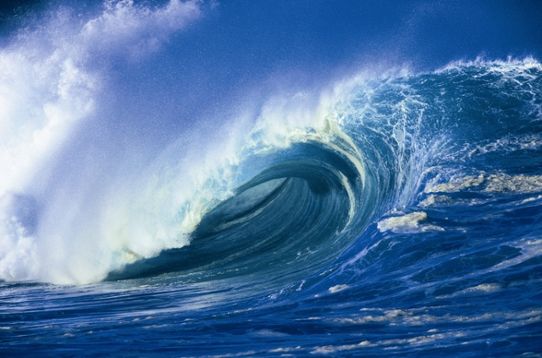When the wind blows across water, energy is transferred to the water, creating both waves and surface currents. These two occurrences develop independently.
Just as for all other wave types, water waves involve the transport of energy, and not the transport of the water mass itself. There is therefore very little net water transport in the direction of the wave.
In deep water particles move in a circular motion when the wave passes. The wave movement decreases with depth and becomes very small at depths greater than half the wave length.

Wave speed and height
The size of a wave is governed by the windspeed, how long it has blown for and the fetch length (the length of water over which the wind has blown). The depth of the water also plays a part.
When waves reach shallower water they change character and slow down as the depth decreases. As they slow down, they become shorter. Conservation of energy (flux) means that the waves increase in height and change form - the swell becomes higher and steeper, ultimately assuming the familiar sharp-crested wave shape. The wave loses stability and the wave breaks. Waves can also break out at sea if the wind is brisk, due to the force of the wind on the wave crests.
Wave height is measured between trough and crest, while the wave length is measured from crest to crest. Wind waves are sometimes called short waves, to distinguish them from swell.
Fully developed sea
The longer the fetch length and the faster the wind speed, the larger and stronger the wave will be. The fetch length is the distance that the wind has blown over an area of sea.
If the wind duration and wind fetch are long enough, the sea becomes ‘fully developed’ and reaches a steady state. The waves have reached a maximum size for that wind speed. The wave energy is also transferred to other energy forms by breaking at the crests, forming white foam (“white horses”). If the winds are strong the entire wave can break and the crests can be blown off, forming long lines of spume.
Waves observed at sea are a combination of many wave systems with waves of varying length and height. The wave height situation is reported by calculating the average of the wave height of the top third of the waves – so you need to measure all the wave heights to work out which ones are in the highest 33%. This wave height is called the significant wave height and came about when it was necessary to relate measured wave heights with the heights reported by trained human observers. The significant wave height is the wave height that a skilled observer would report based on a visual observation. The highest waves are 1.6-1.8 times the significant wave height. Individual waves can be as much as twice the significant wave height.
Velocity of a wave group
When several wave trains are present, the waves form groups. In deep water the groups travel with a group velocity which is half of the speed of the individual waves. The group velocity is the speed at which the wave energy is transported.
It is therefore the group velocity that determines when a wave system reaches a particular location. If you try to follow an individual wave from the wake of a boat, the wave appears to move forward in the system until it disappears out of the front of the group.
The same thing occurs with wind waves out at sea. The largest wave in a group becomes smaller as it moves forwards through the group, while those coming up from the back of the group grow larger as they approach the group’s middle. In deep water, the individual wave are travelling at twice the velocity of the wave group.
How long does it take for the sea to calm down?
When the wind dies down, the waves continue for long distances until they reach the coast. They are a very efficient means of transporting energy. Short waves dissipate fairly quickly, while longer waves can continue for thousands of kilometres, since the viscosity of water is very low. These long waves, decoupled from the local wind field, are called swell.
You may experience a fully developed sea for example if you are in deep water off the coast of Gotland’s southern tip, and there has been a south westerly wind blowing 15 m/s for at least 10 hours across the entire southern Baltic.
In this example the wind fetch from the Polish-German coast is about 200 nm (about 400 km), and only 150 km is needed to allow a fully developed sea to develop. The biggest waves will be 9 m high, 300 m long travelling with a velocity of 27 m/s. The significant wave height would be 5 m with an associated wavelength of 80 m and a velocity of 14 m/s.
Since the group velocity is half the wave velocity, the group’s respective velocities are about 14 m/s and 7 m/s. When the wind stops blowing it would take 5 hours until the last big wave has passed, and 10 hours before the waves as high as the significant wave height have passed.
The longest wind fetch in the Baltic is 800 km. This gives 16 hours until the biggest waves reach the coast and 32 hours before the waves with the significant wave height reach the coast - so you can expect a long wait before you can comfortably go out on the northern Baltic after the wind has blown at 15 m/s for at least 10 hours over the southern Baltic.
If you observe waves starting to increase in size, it can be an early warning that windier weather is on the way, since the waves frequently move faster than the wind itself.